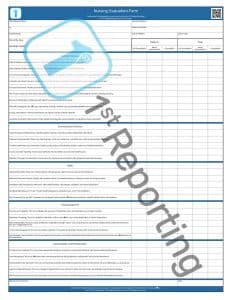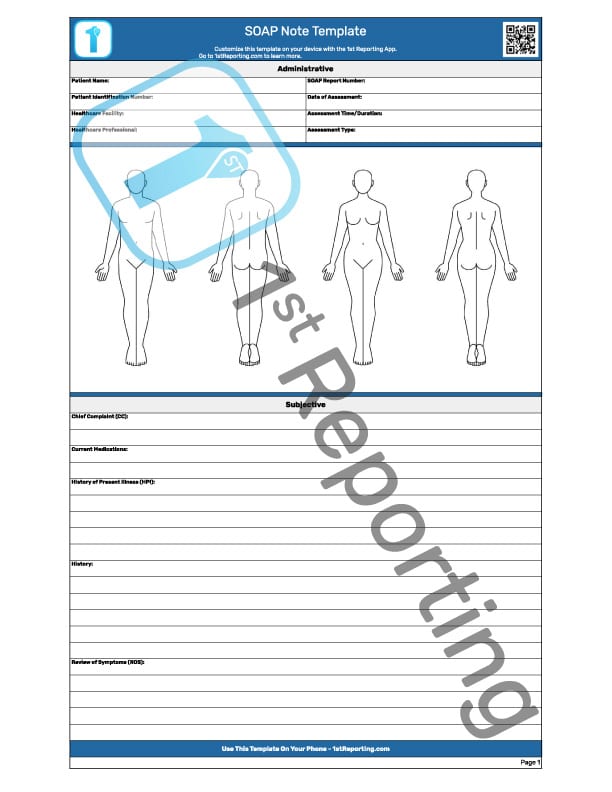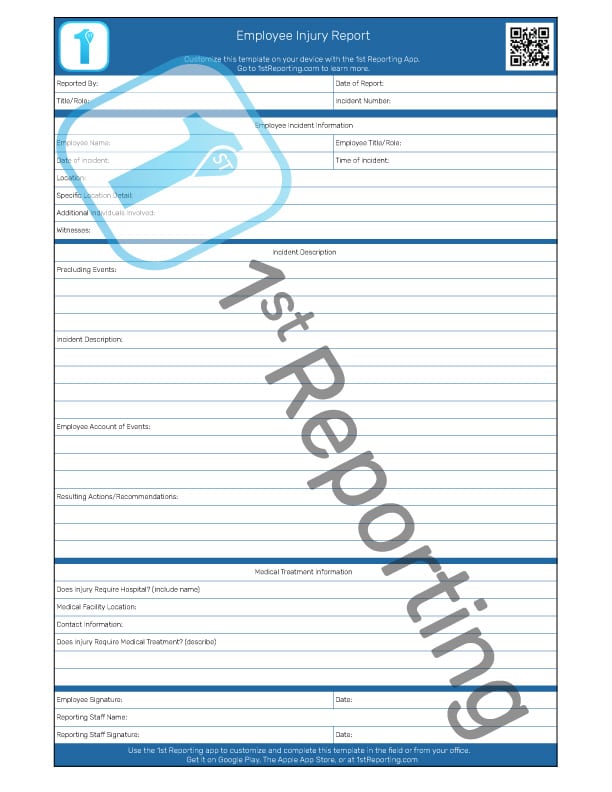As a nursing professional, you know that effective evaluations are the cornerstone of fostering excellence in nursing practice. The journey of every student nurse is one of growth, learning, and the relentless pursuit of providing the best possible care to patients.
But how can we, as evaluators, ensure that this journey is optimized, that our feedback is constructive, and that our documentation is efficient? In today’s fast-paced healthcare environment, the tools we use to assess and guide our future nursing leaders matter more than ever.
In this article, we’ll explore the critical elements that make an evaluation form effective and transformative. From seamless integration into everyday practice to embracing the power of digital technology with 1st Reporting, our goal is to empower nursing professionals to elevate the evaluation process to new heights.
So, whether you’re a clinical instructor, nurse educator, or preceptor, join us as we delve into the art and science of nursing evaluations—shaping the future of healthcare, one evaluation at a time. Let’s get started!
Included In The Ideal Nursing Evaluation Form

Our Nursing Evaluation Form aims to provide you with a concise and comprehensive form to document your nurse evaluation. The form has six segments, which are described below.
Administrative
The administrative section of the Nursing Evaluation Form includes the basic information you need to get a quick view of the who, what, and where of the evaluation process. Furthermore, it’s conveniently broken down into the necessary fields, so you get the information you need at the top of the evaluation form with a glance.
Nursing Processes
Nursing processes are critical for nurse to master their craft. This section of the template offers five high-level inquiries into the nursing process implementation of your evaluated nurse.
Communication Practices
Communication is a huge part of a nurse’s day, be it communicating vital information on a form or report, communicating with other hospital staff, or speaking with patients. This aspect of a nurse’s job is so critical that we felt it ought to find its way closer to the top of the applicable evaluation criteria.
Safety
Safety is paramount in nursing, be it the safety of patients or the safety of hospital staff. Ensuring the appropriate safety precautions are met during scenarios involving contagions is critical. This section deals with the many safety concerns that today’s nurses must face.
Drug Management
Nurses must administer medications, vaccinations, drugs, and other such items. There’s no room for errors when administering the appropriate dosages or the appropriate medications. Nurse evaluation regarding drug administration management
Accountability and Professionalism
Professionalism and accountability are key indicators of a successful nurse. This section of the Nursing Evaluation Form provides crucial insights into the nurse’s growth and development.
How To Put The Nursing Evaluation Form Into Practice

Preparation and Orientation
Educate evaluators and student nurses on the nursing evaluation form’s purpose, objectives, and components. It would be best to provide clear instructions on how to complete the form, emphasizing the importance of objectivity, accuracy, and constructive feedback.
Consistency and Standardization
Ensure that all evaluators use the same standardized nursing evaluation form to promote assessment consistency and fairness. In this case, define and communicate evaluation criteria to help evaluators make informed and consistent judgments.
Timely and Ongoing Evaluations
Schedule evaluations at regular intervals (e.g., mid-term and end-of-term) to provide ongoing feedback and track progress. Conduct evaluations promptly after clinical experiences to capture accurate and relevant observations.
Meaningful Feedback and Goal Setting
Use the evaluation form as a tool for constructive feedback, highlighting areas of strength and areas that require improvement. Collaborate with student nurses to set achievable, measurable goals based on evaluation findings.
Confidentiality and Ethical Considerations
Handle paper-based evaluation forms with care to maintain the confidentiality of student performance data.
Ensure that evaluations are conducted ethically, without bias, and with respect for student privacy.
Fostering Reflection and Self-Assessment
Encourage student nurses to use the evaluation form as a tool for self-assessment and reflection on their clinical performance. Facilitate discussions with student nurses about their evaluation results to promote self-awareness and professional growth.
Record-Keeping and Documentation
Maintain organized and secure records of completed evaluation forms for future reference and program evaluation.
Use evaluation data to inform curriculum development, identify trends, and enhance the quality of nursing education.
Review and Improvement
Periodically review and update the nursing evaluation form to ensure that it remains relevant and aligned with best practices and program objectives. Solicit feedback from evaluators and student nurses to improve the evaluation process and form continuously.
Implementing Digital Nursing Evaluations

The ever-evolving healthcare landscape demands innovation and adaptability, and nursing education is no exception. For years, nursing professionals have relied on traditional paper-based evaluations to assess the performance and competence of student nurses.
While these evaluations have played a crucial role in shaping nursing practice, they are not without their limitations. Inefficiencies, delays, and inaccuracies can hinder the evaluation process, leaving room for improvement in how we guide our future nurses.
As we strive for excellence in nursing education, the shift from paper-based evaluations to digital solutions is a natural and necessary progression. Digital nursing evaluations bring the power of technology to the forefront, allowing evaluators to capture insights, provide feedback, and track progress with unprecedented ease. By leveraging the potential of digital tools, we can streamline the evaluation process, enhance its accuracy, and optimize the learning experience for student nurses.
Real-Time Communication
In today’s fast-paced healthcare environment, real-time feedback and accessibility are paramount. Digital nursing evaluations allow evaluators to assess performance and provide feedback at the point of care, facilitating timely and meaningful interactions.
Moreover, digital evaluations are accessible from any device—be it a computer, tablet, or smartphone—enabling evaluators and students to collaborate and engage virtually anywhere.
Efficiency In Reporting Practices
Efficiency is another key advantage of digital evaluations. Gone are the days of manual data entry, paper filing, and sorting through stacks of documents. With digital evaluations, all relevant information is readily available, organized, and secure, freeing up valuable time for what matters most: fostering growth and excellence in nursing practice.
As we embrace the digital age, it is clear that digital nursing evaluations are not just a trend but rather an indispensable tool for nurturing the next generation of nursing leaders. Let’s explore how this shift can transform nursing education and elevate patient care.
Further Benefits of Implementing Digital Nursing Evaluations
Enhanced Efficiency and Time Savings
I mentioned earlier how utilizing a standard Nursing Evaluation Form is beneficial. However, the issue with the traditional paper-based evaluation forms is that if your organizational size is large, the dissemination of updated or revised forms can pose a serious challenge.
With a digital reporting platform, form changes are instantaneously disseminated amongst all users. There’s never a worry about a change-over period of days or weeks. Now, a form change takes seconds, eliminating extra labor and paper clutter caused by defunct printed forms.
Improved Accuracy and Consistency
Doctor’s handwriting is notorious for being illegible. Some nurses share the same issue, and thus consistency in their accurate reporting suffers.
Utilizing a digital reporting platform, you negate the issues of illegible writing. Furthermore, with a customizable template editor, you can ensure that field settings are set to prevent a form from moving on until the person completing the form completes the forced fields. This practice reduces errors exponentially compared with paper reporting and ensures a much higher degree of accuracy.
Greater Accessibility and Collaboration
Forms and charts are easy to misplace and require strict adherence to paper protocol. Many hospitals, clinics, and other healthcare facilities go to great lengths to set up, administer, and maintain complicated paperwork processes. However, with a digital form solution, you can deliver greater accessibility for all key stakeholders. Everyone involved can collaborate easily by using the application on various devices.
Using our automated notification system, you can set up instant notifications. So when a team member completes a specific form or report, the assigned supervisor is instantly notified, allowing for report review in real time. Collaboration has never been easier.
Key Features of the 1st Reporting Application
Integration doesn’t have to be a challenge when you adopt 1st Reporting. Our team is dedicated to providing you with solutions that work, including adopting a digital system into your operations.
User-Friendly Interface and Customizable Templates
1st Reporting has a simple and intuitive interface. The management dashboard and your user’s dashboards are both simple yet powerful. The report manager has an innovative map view (customizable, of course) that lets you see your team’s reports right on a map of your choice.
1st Reporting also has a template builder where you can take your custom templates to the next level. The builder fully allows you to customize your digital reports to suit your organizational needs. It’s powerful, convenient, and saves countless daily hours for organizations like yours.
Secure Data Storage
Your internal reports are critical to maintaining your operation, and the security of your operation is essential. Although 1st Reporting is a mobile application that your team can use on any device, from anywhere, all your data is completely secure on our cloud-based architecture. We know your data security’s importance and take it seriously—trust 1st Reporting to maintain the integrity of your information.
Seamless Integration with Existing Systems
Our platform was built from the ground up with you in mind. That means we understand how critical it is that you can easily access and use our platform with your existing systems.
1st Reporting works seamlessly with many platforms, including Microsoft Teams®. You don’t even have to be logged into 1st, as long as you have Teams open already. You can still receive and share information on the 1st Reporting network.
Optimizing report management and reporting practices doesn’t have to be a nightmare. And with the solutions brought to you by 1st Reporting, be it a printable report, a guide (like our guide on SOAP notes), or our advanced 1st Reporting platform, you know that the industry standard, 1st Reporting, has got your back.




